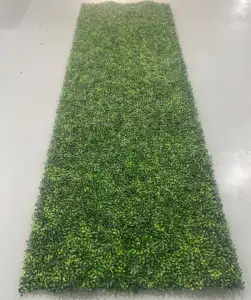Introduction
Green wall decor is a rising trend in the dynamic world of interior design, redefining our living and working spaces. This innovative concept, with roots in ancient Babylon, has evolved into a modern design trend that combines aesthetic appeal with environmental benefits. This article explores the history, understanding, and popularity of green wall decor, its environmental benefits, and psychological advantages. We'll also guide you on how to incorporate this trend into your interiors, select the right plants, and maintain your green wall effectively.
The Emergence of Green Wall Decor
The concept of green wall decor can be traced back to ancient Babylon, where the first building with a built-in irrigation system was constructed. The modern green wall system was developed in the 1930s, and the concept of vertical gardens was popularized globally, inspiring the world with its creations.
Understanding the Green Wall Decor Trend
The trend of green wall decor, particularly artificial green wall plants, is gaining momentum. These plants offer a fresh, vibrant aesthetic that brings the outdoors inside. They are low-maintenance, versatile, and customizable to fit any space. With a variety of styles and sizes available, artificial green wall plants can fit into any design scheme, making them a popular choice. They are an eco-friendly choice, made from durable materials, reducing waste and carbon footprint.
Why Green Wall Decor is Gaining Popularity
Green wall decor is gaining popularity due to its numerous benefits. Indoor living walls introduce a large number of toxin-cleaning plants into interior spaces without taking up floor space. They improve indoor air quality, create a beautiful environment, and contribute to the wellbeing of occupants. Additionally, plants absorb, diffract, and reflect sound, altering room acoustics and reducing reverberation time. This trend is not just about aesthetics; it's about creating healthier, more enjoyable spaces.
Environmental Benefits of Green Wall Decor
Green wall decor, also known as living walls, offer significant environmental benefits. They help in mitigating air pollutants, capturing toxins, gases, and particulate matter through natural processes, a phenomenon known as biogenic regulation. Additionally, they contribute to reducing the urban heat island effect by lowering temperatures through evapotranspiration. Living walls also enhance urban biodiversity, providing vital nesting space, shelter, and food for birds and insects. This green infrastructure not only improves air quality but also creates a well-balanced local ecosystem.
Aesthetic and Psychological Advantages of Green Wall Decor
The innate instinct we have to connect with nature, known as biophilia, plays a significant role in the appeal of green wall decor. Research suggests that incorporating elements of nature into our surroundings can boost our mood, reduce stress, and enhance creativity. Indoor plants, a key component of green wall decor, offer a vital link to the natural world, promoting a sense of well-being and productivity. Even looking at a photograph of a green setting can help reduce stress, indicating the powerful psychological benefits of green wall decor.
Incorporating Green Wall Decor in Your Interiors
Green wall decor is incredibly versatile, offering a range of shades that can create different atmospheres. For a calming ambiance, consider lighter or darker tones paired with tactile fabrics. Green can be introduced through bold paint or subtle patterns, and it pairs well with many other colors. However, it's important to consider the existing colors in your space, including furniture, flooring, and artwork. Whether you're considering a bold block color or introducing green through pattern, there are many ways to incorporate green wall decor in your interiors.
Choosing the Right Plants for Your Green Wall
Choosing the right plants for your green wall is crucial. Some of the best plants for indoor living green walls include Pothos, Maranta, Fern, Spider Plant, Dracaena, Syngonium, Peperomia, Tradescantia, Palm, and Ivy. These plants are known for their adaptability to indoor environments and their ability to thrive on living walls. They add a touch of nature to your interiors, enhancing the aesthetic appeal while also offering environmental benefits.
Design and Maintenance Tips for Your Green Wall
Maintaining a green wall is crucial for its longevity. It's important to gain and retain client commitment for long-term care. Training and professional accreditation can enhance your expertise in green wall maintenance. Accessibility is a key factor in maintenance, considering the scale and height of some living walls. Smart planning can save time and effort during routine visits. Lastly, remote monitoring systems can provide continuous data and immediate alerts of potential problems, ensuring the vitality of your green wall.
Conclusion
Green wall decor is more than just a design trend; it's a movement towards healthier, more sustainable living spaces. Its roots in history and its modern-day popularity underline its timeless appeal. From improving air quality to enhancing mood and productivity, the benefits of green wall decor are manifold. With a variety of styles and plants to choose from, it offers versatility in design, allowing you to create a space that's uniquely yours. However, the longevity of a green wall depends on proper maintenance and care. As we continue to seek ways to connect with nature in our built environments, green wall decor stands as a testament to the power of biophilic design.








































 浙公网安备 33010002000092号
浙公网安备 33010002000092号 浙B2-20120091-4
浙B2-20120091-4